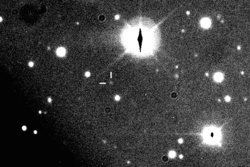Euporie (moon)
Topic: Astronomy
 From HandWiki - Reading time: 2 min
From HandWiki - Reading time: 2 min
Short description: Outer moon of Jupiter
 Discovery images of Euporie by the Canada-France-Hawaii Telescope in December 2001 | |
| Discovery[1] | |
|---|---|
| Discovered by | Scott S. Sheppard et al. |
| Discovery site | Mauna Kea Obs. |
| Discovery date | 11 December 2001 |
| Designations | |
Designation | Jupiter XXXIV |
| Pronunciation | /ˈjuːpəriː/[2] |
| Named after | Ευπορία Eyporia |
| S/2001 J 10 | |
| Adjectives | Euporian /juːˈpɔːriən/[3] |
| Orbital characteristics [4] | |
| 19302000 km | |
| Eccentricity | 0.144 |
| Orbital period | −550.7 days |
| Mean anomaly | 293.0° |
| Inclination | 145.8° |
| Longitude of ascending node | 64.9° |
| 74.6° | |
| Satellite of | Jupiter |
| Group | Ananke group |
| Physical characteristics | |
| Mean diameter | 2 km |
| Apparent magnitude | 23.1 |
Euporie /ˈjuːpəriː/, also known as Jupiter XXXIV, is a natural satellite of Jupiter. It was discovered by a team of astronomers from the University of Hawaii led by Scott S. Sheppard in 2001, and given the temporary designation S/2001 J 10.[5][1]
Euporie is about 2 kilometres in diameter, and orbits Jupiter at an average distance of 19.266 million km in 550.69 days, at an inclination of 145.7° to the ecliptic, in a retrograde direction and with an eccentricity of 0.148.[6] It is affected by the Kozai mechanism.[7]
It was named in August 2003 after Euporie, a Greek goddess of abundance and one of the Horae in Greek mythology (and thus a daughter of Zeus).[8] It is a member of the Ananke group.
References
- ↑ 1.0 1.1 Brian G. Marsden (15 May 2002). "MPEC 2002-J54: Eleven New Satellites of Jupiter". International Astronomical Union Minor Planet Center. http://www.minorplanetcenter.net/iau/mpec/K02/K02J54.html.
- ↑ per eupory (3rd ed.), Oxford University Press, September 2005, http://oed.com/search?searchType=dictionary&q=eupory (Subscription or UK public library membership required.)
- ↑ per euporia (3rd ed.), Oxford University Press, September 2005, http://oed.com/search?searchType=dictionary&q=euporia (Subscription or UK public library membership required.)
- ↑ S.S. Sheppard (2019), Moons of Jupiter, Carnegie Science, on line
- ↑ Daniel W. E. Green (16 May 2002). "IAUC 7900: Satellites of Jupiter". International Astronomical Union. http://www.cbat.eps.harvard.edu/iauc/07900/07900.html.
- ↑ "Planetary Satellite Mean Elements". https://ssd.jpl.nasa.gov/sats/elem/.
- ↑ Brozović, Marina; Jacobson, Robert A. (2017-03-09). "The Orbits of Jupiter's Irregular Satellites". The Astronomical Journal 153 (4): 8. doi:10.3847/1538-3881/aa5e4d. ISSN 0004-6256. Bibcode: 2017AJ....153..147B.
- ↑ Daniel W. E. Green (9 August 2002). "IAUC 8177: Satellites of Jupiter, Saturn, Uranus". International Astronomical Union. Archived from the original on 27 March 2012. https://web.archive.org/web/20120327153049/http://www.cbat.eps.harvard.edu/iauc/08100/08177.html.
 |
Licensed under CC BY-SA 3.0 | Source: https://handwiki.org/wiki/Astronomy:Euporie_(moon)6 views | Status: cached on September 20 2024 15:33:56↧ Download this article as ZWI file
 KSF
KSF